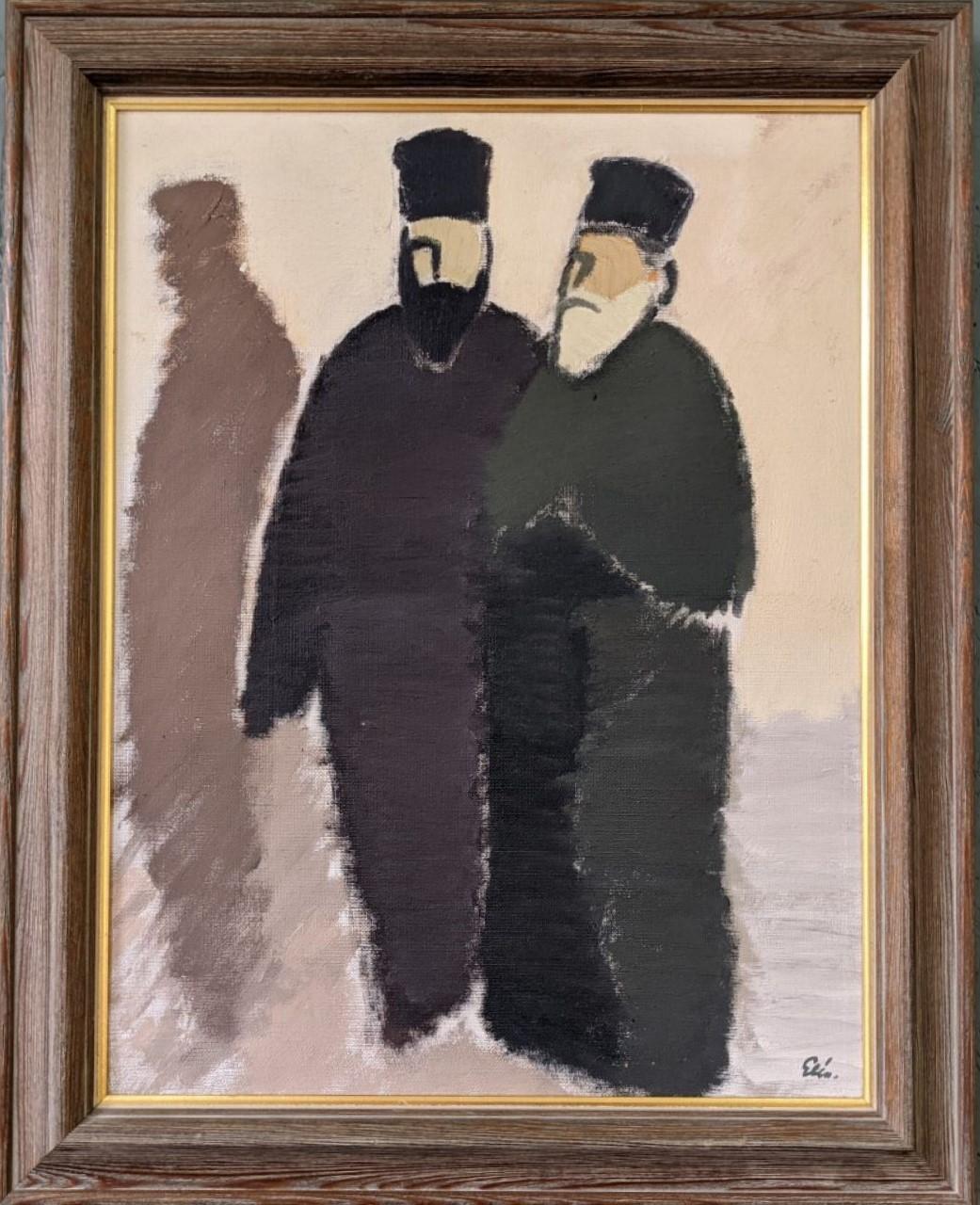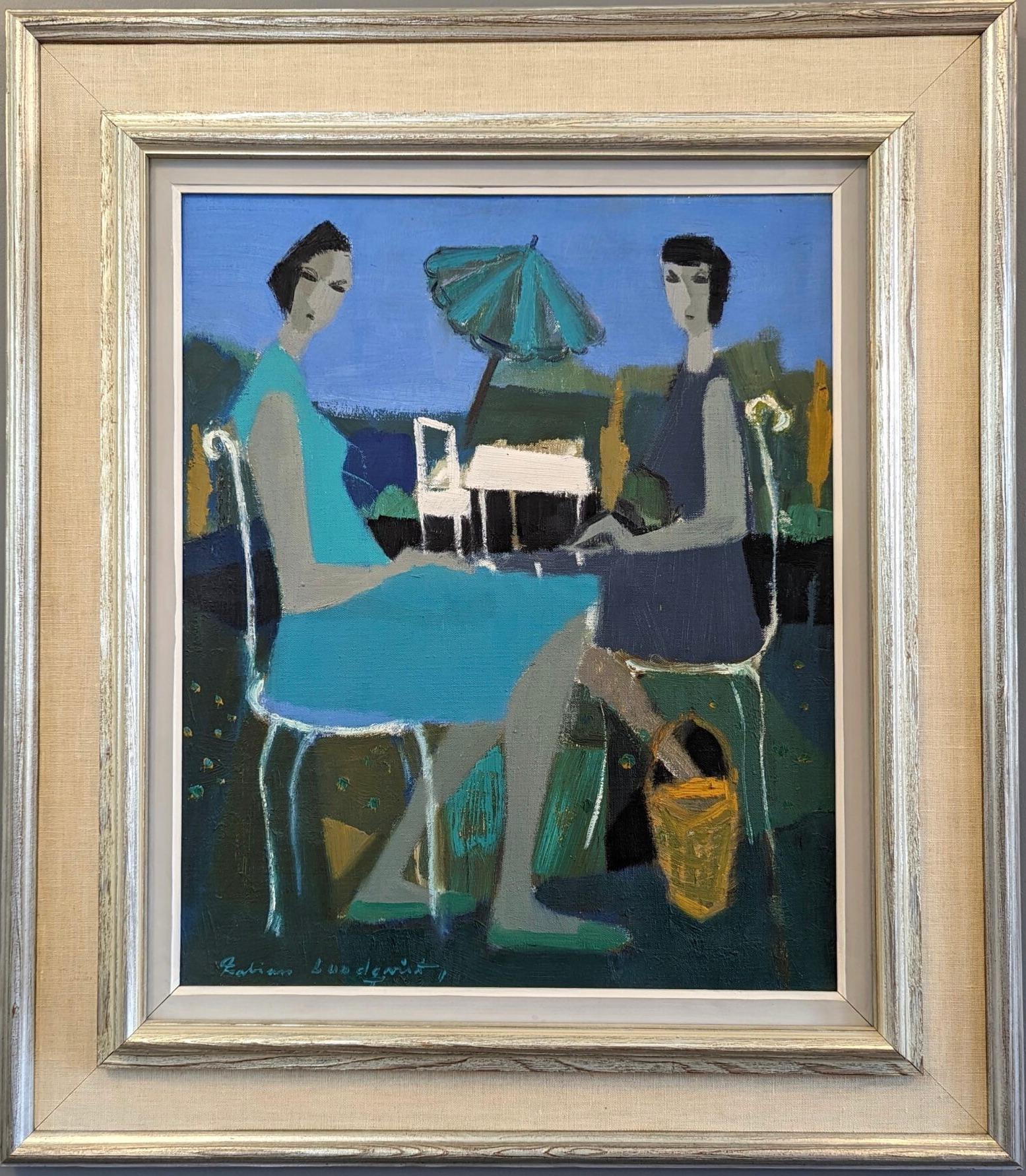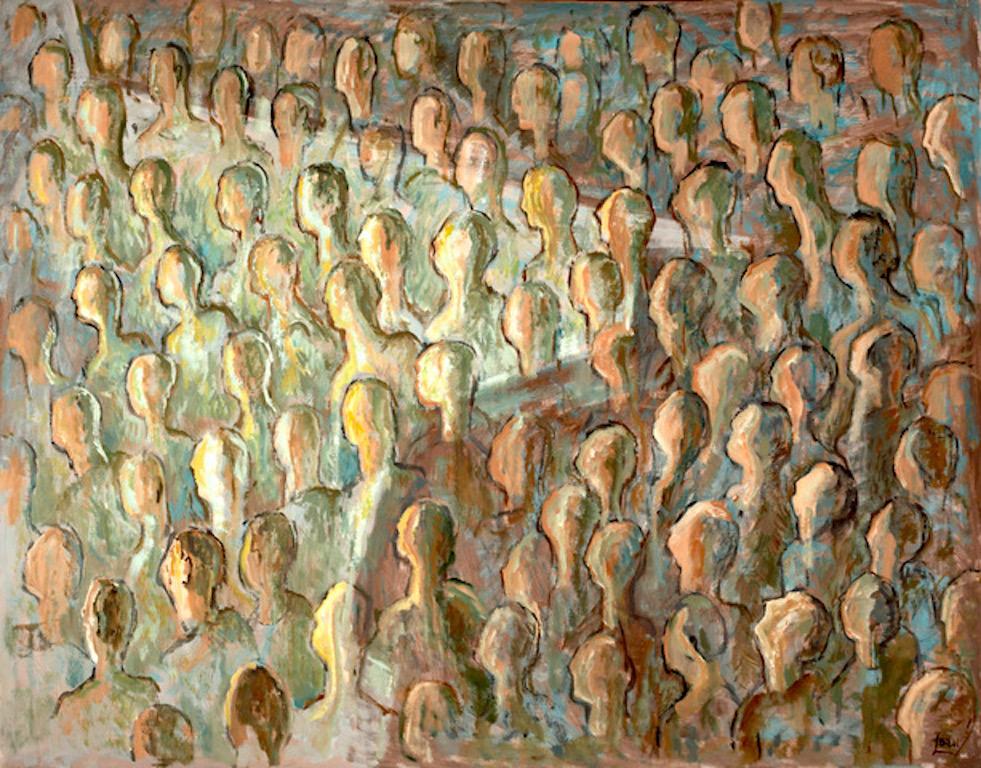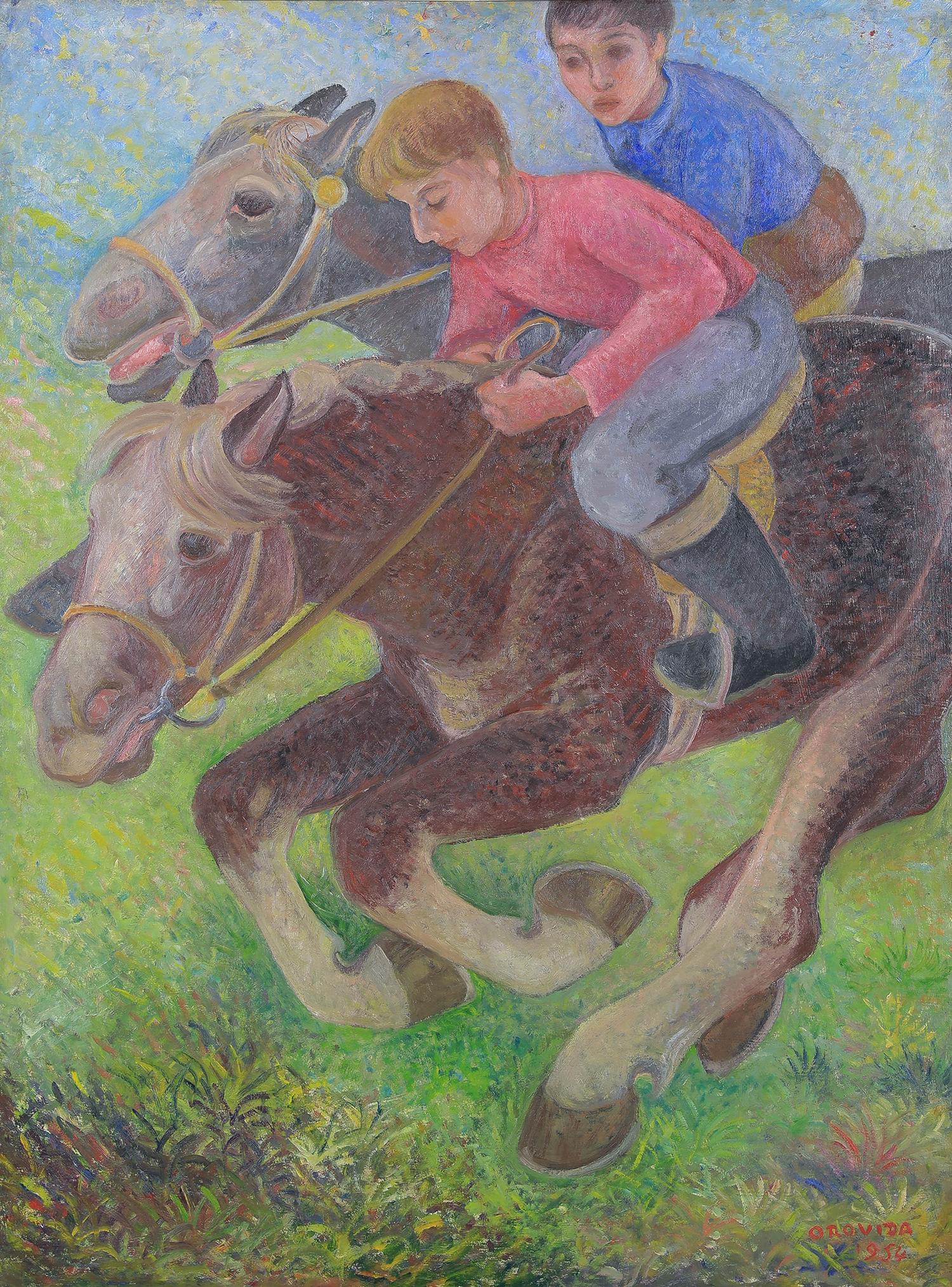Items Similar to Farmer busy eating his lunch, (I think he's just boozing) by Axel Soeborg
Want more images or videos?
Request additional images or videos from the seller
1 of 14
Axel SoeborgFarmer busy eating his lunch, (I think he's just boozing) by Axel Soeborg
About the Item
Søeborg, Axel (1872-1939)
The ochre yawn of autumn and the bitter sleep of winter are the preoccupations of Danish artist Axel Søeborg's landscapes. With his singular hand, Søeborg spent twenty years capturing the rich palette of the Nordic countryside. He also had a penchant for dark interiors and contemplative, psychological self-portraits.
Søeborg's artistic career began as a house painter, but he soon changed his mind and turned to a more refined style of art. He began his studies at the drawing school of the Vermehren brothers, Gustav and Sophus, sons of the eminent Frederik Vermehren (1823-1910). His training continued at the Royal Danish Academy of Fine Arts, and with the figure painters Laurits Tuxen (1853-1927) and Peter Alfred Schou (1844-1914). Schou's dark interiors and moody scenes were Søeborg's greatest source of inspiration.
Søeborg lends a contemplative, insightful atmosphere to close-up, curious depictions of simply furnished interiors. The gaze of his subjects, usually himself and an unknown woman, is imbued with psychological intensity. They fix the viewer with a piercing gaze. Combined with a strong use of shadow to envelop the rooms in intimacy, and a radiant use of light to make his subjects the focus of the scenes, the viewer is drawn into a scene filled with emotion.
Indeed, his self-portraits in particular have this intense quality. A striking Søeborg is depicted in strong, almost cubist lines, in profile but with his eyes fixed on the viewer. His gaze is heavy, his eyebrows very pronounced. Søeborg's strong use of light and shadow adds to the gravity, giving the scene a curious, otherworldly effect. One gets the impression that melancholy thoughts lurk behind those eyes. Combined with the darkness of the room, the tone is pensive and somber.
It's interesting to wonder what the painting offered Søeborg. Perhaps it was a mirror in which he could reflect the way he saw himself and the world around him. The psychological aspect that seems to underlie these works could be the cause. Whatever the case, it seems clear that he felt the emotional intensity of painting and used it to experiment with the medium as well as to explore his own perception of himself.
Beyond the interior, Søeborg also found much inspiration in the natural world. During the twenty years he spent living and traveling in Sweden, he captured the changes and transformation of nature as the seasons passed.
From Jamtland to Dalarna, across Småland, Søeborg's psychological brush seems to capture the emotion as well as the physical changes of nature.
Through his judicious use of lighting, Søeborg seems to imbue his canvases with the mood of nature. An autumn fire sets her canvas ablaze with ochre and earthy umber, obscuring the sky. A silvery sheet of suffocating winter descends on a village, smothering it in snow and adding an oppressive coldness. Then spring arrives, piercing the veil of immobility. Water flows freely, reflecting the bare arc of a stretched branch. The sumptuous grass and brightening sky in the background promise new life.
These fascinating representations of nature and the self did not enjoy immediate success in the art world. However, thanks to numerous exhibitions throughout Europe, Søeborg eventually gained recognition. A solo exhibition in 1937, one of many, sealed the deal. Søeborg died unexpectedly two years later.
Today, many of his works are preserved in museums in Aalborg and Sønderborg, Denmark.
- Creator:Axel Soeborg
- Dimensions:Height: 26.38 in (67 cm)Width: 26.38 in (67 cm)Depth: 1.58 in (4 cm)
- Medium:
- Movement & Style:
- Period:
- Condition:
- Gallery Location:Gent, BE
- Reference Number:1stDibs: LU2140213775342
About the Seller
5.0
Vetted Seller
These experienced sellers undergo a comprehensive evaluation by our team of in-house experts.
Established in 2018
1stDibs seller since 2022
Typical response time: 1 hour
- ShippingRetrieving quote...Ships From: Gent, Belgium
- Return PolicyA return for this item may be initiated within 10 days of delivery.
More From This SellerView All
- Interior of church Oil on panel - Enrique MÉLIDA (1838 – 1892)Located in Gent, VOVEnrique Mélida y Alinari, (1838 - 1892) Enrique Mélida was a Spanish painter, lithographer and writer. Through his marriage to Marie Bonnat, he is the brother-in-law of the painter ...Category
19th Century Figurative Paintings
MaterialsCanvas, Oil
- The Matchmaker, oil on canvas by Jan Baptist LambrechtsBy Jan Baptist LambrechtsLocated in Gent, VOVJan Baptist LAMBRECHTS (Antwerp, 1680 - after 1731), L'entremetteuse Canvas. On verso, wax stamp. 40 x 31 cm Expert : M. René MILLET Lambrechts was born in Antwerp in 1680. His fathe...Category
17th Century Figurative Paintings
MaterialsCanvas, Oil
- Farewell, oil on panel by Johannes Stroebel (1821-1905)Located in Gent, VOVFarewell, oil on panel by Johannes Stroebel (1821-1905) Length: 25 (unframed) Height: 32 (unframed) Signed on the right Presented in its original frame Johannes Anthonie Balthasar S...Category
19th Century Figurative Paintings
MaterialsCanvas, Oil
- The blind man, oil on canvas by Maurice LangaskensBy Maurice LangaskensLocated in Gent, VOVA masterfully painted scene originating from the artist's studio In this painting, Langaskens brings together several motifs that were also the subject of his graphic work: the blind man, the priest, the nun and the farm that also appears in the famous etching "les toits rouges" (the red roofs). These elements are brought together in a dynamic and colourful composition, where the similarities to that other Belgian painter, Anto Carte, are striking. Combining these elements in this way creates a certain tension. Is the work about mercy (helping a blind man), or are we spectators of a scene where a poor wretch's purse is stolen? Striking is the use of impasto, in which the painter emphasises the texture of fabrics and skin via flowing lines. Maurice Langaskens 1884 - 1946 Biography A Belgian painter and printmaker, Maurice (Maurits) Langaskens enrolled in the Académie Royale des Beaux-Arts in Brussels in 1901, and was trained as a decorative painter by the leading Belgian muralist and sculptor Constant Montald. From early on, Langaskens was recognized as a fine draughtsman, and won several prizes at the Académie. After living and studying for a few months in France in 1906, mainly in Dijon, the young Langaskens settled in Schaerbeek, outside Brussels. He began his independent career in 1907, when he exhibited three decorative paintings at the Salon in Brussels for the first time and also had an exhibition of his work shown at the Salle Boute in the city. The following year he contributed six paintings to the 16th annual exhibition of the Belgian artist’s association ‘Pour l’Art’ in Brussels, where he was to exhibit frequently over the course of his later career, until 1941. (Langaskens also designed the poster for the 17th ‘Pour l’Art’ exhibition in 1909.) Also in 1908, one of his paintings was selected for an exhibition of modern Belgian art in Berlin. Much of Langaskens’s early work was in a vibrant and visually arresting Art Nouveau or Symbolist style. This bold and colourful manner also translated well into large-scale mural commissions, and he soon became one of the leading painter-decorators of the early 20th century in Belgium. His decoration of the town hall of the city of Zoutleeuw in 1912 earned the artist considerable fame and the praise of his teacher and mentor Montald: ‘He was one of the best students in the class; today he is the most outstanding artist among the decorators of our time.’ The same year the first of several exhibitions of Langasken’s work was mounted at the Cercle Artistique et Littéraire in Brussels. The outbreak of the First World War, however, brutally interrupted the rise of the artist’s successful career. Drafted into the Belgian army at the beginning of August 1914, Langaskens was captured by the Germans after less than a fortnight. He spent the next three and half years as a prisoner of war, at internment camps at Sennelager, Münsterlager and Göttingen. He produced numerous, mostly small-scale paintings and watercolours of portraits and depictions of many of his fellow prisoners, as well as scenes of daily camp life, that are today regarded as among his finest and most personal works. It was also during this period that he painted two of his best-known pictures, the large canvas In Memoriam, painted in 1916 and depicting the burial of a Belgian soldier by his comrades, and the monumental triptych Repose en Paix, painted between 1915 and 1918. After his liberation and return to Belgium, Langaskens exhibited over eighty of the paintings and drawings that he had produced as a prisoner of war at the Galerie Sneyers in Brussels in 1918. After the Armistice, Langaskens - suffering from aphasia and nervous disorders brought about by his long confinement - painted mainly easel pictures of winter landscapes, rustic genre scenes and floral subjects, and also produced a number of designs for tapestries, book illustrations and stained-glass windows. Within a few years, however, his health had recovered and he returned to undertaking large-scale decorative mural commissions. In 1920 Langaskens was one of the founders, alongside Montald, Jean Delville, Emile Fabry...Category
20th Century Figurative Paintings
MaterialsCanvas, Oil
- Horses resting at the watering place Oil on canvas by Jules Pierre Van BiesbroecLocated in Gent, VOVHorses resting at the watering place Oil on canvas by Jules Pierre Van Biesbroeck Jules Van Biesbroeck was born in Italy in 1873 during h...Category
20th Century Figurative Prints
MaterialsCanvas, Oil
- Riders and Bedouins walking on a path near a cliff, Oil on panel by Honoré BOZELocated in Gent, VOVCavaliers et bédouins marchants sur un chemin près d’une falaise. (panneau 32 *20 cm) Honoré Boze est un peintre orientaliste français, né à l'île Maurice...Category
19th Century Figurative Paintings
MaterialsCanvas, Oil
You May Also Like
- Yellow Symphony #1Located in Bogotá, BogotáThis horizontal painting on canvas contains several layers of color, with textures and transparencies, representing a dreamlike scene where fantastic animals and humans in yellow and...Category
2010s American Modern Figurative Paintings
MaterialsOil, Canvas
- Vintage Mid-Century Modern Swedish Figurative Framed Oil Painting - The PriestsLocated in Bristol, GBTHE PRIESTS Size: 60 x 48 cm (including frame) Oil on canvas A brilliantly painted mid century figurative portrait of 2 priests, exec...Category
1950s Modern Figurative Paintings
MaterialsCanvas, Oil
- Mid-Century Modern Figurative Oil Painting, Fabian Lundqvist - Garden VacationLocated in Bristol, GBGARDEN VACATION Size: 67 x 59 cm (including frame) Oil on Canvas A charming mid-century figurative composition, executed in oil onto canvas by the established Swedish artist Fabian ...Category
1960s Modern Figurative Paintings
MaterialsCanvas, Oil
- "Audience" Mid 20th Century American Figurative Theatre Performance ContemporaryBy Leon BibelLocated in New York, NY"Audience" Mid 20th Century American Figurative Theatre Performance Contemporary Leon Bibel (1912 - 1995) "The Audience," 52 ½ x 41 ¼ inches. Oil on canvas, c. 1963. Signed lower right. Framed. BIO Painter, printmaker and sculptor, Leon Bibel was born in San Francisco in 1913. He trained at the California School of Fine Arts and received a scholarship to study under the German Impressionist Maria Riedelstein. He worked in collaboration with Bernard Zackheim, a student of Diego Rivera, to create frescoes for the San Francisco Jewish Community Center and the University of California Medical School. In 1936 Bibel moved from California to join the Federal Art Project at Harlem Art...Category
1960s American Modern Figurative Paintings
MaterialsCanvas, Oil
- 1960's French Modernist Signed Oil Man Driving 1900's Vintage CarLocated in Cirencester, GloucestershireArtist/ School: Jean-Pierre Rousseau (French, b. 1939), signed and dated 1963. Title: The Vintage Car Driver Medium: signed oil painting on canvas, framed and inscribed verso. f...Category
Mid-20th Century Modern Landscape Paintings
MaterialsCanvas, Oil
- Animal painting by Orovida Camille Pissarro titled 'Exercising Ponies'By Orovida PissarroLocated in London, GB*UK BUYERS WILL PAY AN ADDITIONAL 20% VAT ON TOP OF THE ABOVE PRICE Exercising Ponies by Orovida Camille Pissarro (1893-1968) Oil on board 101.5 x 76 cm (40 x 30 inches) Signed and dated lower right Orovida 1954 Provenance Estate of Orovida Pissarro With John Bensusan-Butt, cousin of the artist Sotheby's London, 12th October 1988 G Hassell, 25th November 1988 With John Noott, 10th June 1992 Literature K L Erickson, Orovida Pissarro: Painter and Print-Maker with A Catalogue Raisonné of Paintings, (doctoral thesis), Oxford, 1992, Appendices, no. 161 (illustrated) Exhibitions London, Bowmore Gallery, Women in Art 1850-1989, 2nd-11th November 1989 Fort Lauderdale, Museum of Art, Camille Pissarro and his Descendants, January-April 2000, no.123 This work was included in the above important museum exhibition and a catalogue of the Fort Lauderdale museum show will be included with this painting. Biography Orovida Camille Pissarro, the only child of Lucien and Esther Pissarro, was the first woman in the Pissarro family to become a professional artist and the first Pissarro of her generation to take up painting. Born in Epping, England, in 1893, she lived and worked predominantly in London, where she was a prominent member of several British arts clubs and societies. She first learned to paint in the Impressionist style from her father and, after a brief period of formal study with Walter Sickert in 1913, she renounced formal art schooling. Throughout her career, Orovida always remained outside mainstream British art movements. Much to Lucien's disappointment, she soon turned away from naturalistic painting and developed an unusual style that combined elements of Japanese, Chinese, Persian and Indian art. Her rejection of Impressionism, which, for the Pissarro family, was a way of life, and her simultaneous decision to drop her famous last name and use simply Orovida as a nom de peintre, reflected a desire for independence and distance from the family legacy, of which she nevertheless remained proud. Orovida's most distinctive works are her paintings from the 1920s...Category
1950s Modern Animal Paintings
MaterialsOil, Canvas




